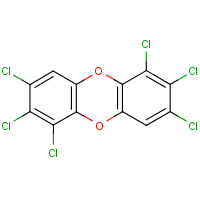1,2,3,6,7,8-Hexachlorodibenzo-p-dioxin
Agent Name
1,2,3,6,7,8-Hexachlorodibenzo-p-dioxin
CAS Number
57653-85-7
Formula
C12-H2-Cl6-O2
Major Category
Other Classes

Synonyms
1,2,3,6,7,8-HXCDD; 1,2,3,6,7,8-Hexa polychlorinated dibenzo-p-dioxin; 1,2,3,6,7,8-Hexachlorodibenzo-para-dioxin; 1,2,3,6,7,8-Hexachlorodibenzodioxin; Dibenzo(b,e)(1,4)dioxin, 1,2,3,6,7,8-hexachloro-; Dibenzo-p-dioxin, 1,2,3,6,7,8-hexachloro-; [ChemIDplus]
Category
Halogenated Polyaromatics
Description
White solid; [CAMEO] White crystals; [MSDSonline]
Sources/Uses
Found in emissions from waste incineration and PCB transformer fires and as impurity in chlorinated pesticides and pentachlorophenol; Not commercially produced; [HSDB] Hexachlorodibenzo-p-dioxins (HCDD): Found as impurities in polychlorinated phenols and chlorophenol derivative herbicides (i.e. 2,4-D); [NTP]
Comments
Ingestion, inhalation and skin contact to this class of compounds has caused chloracne and liver injury; [CAMEO] Polychlorodibenzodioxins have caused chloracne in humans; Produced acnegenic response in rabbit ear bioassay; Teratogenic in rats at doses maternally toxic; Hexachlorodibenzo-p-dioxin mixtures have induced carcinomas, adenomas and non-neoplastic lesions in experimental animals by ingestion and external application; Oral LD50 (rat) = 1.8 (male) and 0.8 (female) mg/kg bw (31% 1,2,3,6,7,8- and 67% 1,2,3,7,8,9-hexachlorodibenzo-p-dioxins); [HSDB] No evidence of carcinogenicity in mice with dermal application, but carcinogenic effects, including hepatocellular carcinomas, observed in gavage study with rats and mice (mixture of 1,2,3,6,7,8- and 1,2,3,7,8,9-hexachlorodibenzo-p-dioxins); [NTP] IARC classification is for polychlorinated dibenzo-para-dioxins other than 2,3,7,8-Tetrachlorodibenzo-p-dioxin (TCDD);
Biomedical References
Exposure Assessment
Vapor Pressure
3.6E-11 mm Hg
Adverse Effects
Hepatotoxin
Hepatoxic (a) from occupational exposure (secondary effect) or (b) in animal studies or in humans after ingestion
Reproductive Toxin
Yes
Dermatotoxin
Chloracne
IARC Carcinogen
Not classifiable
NTP Carcinogen
Anticipated human carcinogen
Diseases, Processes, and Activities Linked to This Agent
Diseases
Occupational diseases associated with exposure to this agent: